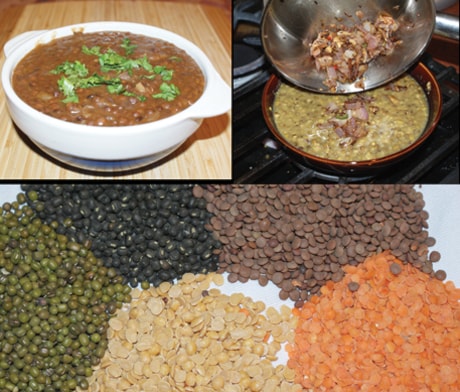Dahl in India is what chicken soup is in Canada — a staple comfort food. Dal, daal, dahl, however you spell it, is a dish cooked daily in the Indian kitchen. This spicy soup is made using “pulses,” or lentils that are cooked until they are made into a thick stew.
In India, “dahl” is a general term used to encompass all lentils and as well as the spicy soup. Each region of India has its own favourite dahl with their own accompanying flavours. Commonly, however, lentils are seasoned with onion, garlic and ginger, in addition to the staple spices of turmeric, garam masala, cumin and coriander.
Only conundrum when making dahl is trying to decide which lentils to use. I remember coming home from school and asking my mom which dahl we would be eating today. Her reply used to be the ‘black dahl’, ‘green dahl’, ‘yellow dahl’, ‘pink dahl’, ‘white dahl’ and so on. There are so many types and varieties of dahls that, to me, the only way to remember them was by their colours.
My five favourite lentils and probably the most popular in the Indian cook’s pantry are, masoor whole (brown), masoor split (red or pink), toor (yellow), urad (black) and moong (green).
Massoor whole lentil is brown. Even though they can be prepared whole, Indian recipes often call for the skinned and split masoor. Skinned split masoor beans are actually called red lentils (red or salmon in color). When cooked the whole massoor forms a brown thick dahl while the skinned split turns into a vibrant yellow.
Toor lentil is a split pigeon pea that has a subtle nutty flavour. It is one of the yellow coloured dahl. Urad and Moong dahls are whole lentils with their characteristic black and green skin colour. These latter varieties hold their shape very well and thus take a long time to cook.
Most dahl recipes are quite simple to prepare. The standard preparation begins with cooking lentils in water with some turmeric and salt , and then adding a tadka or tempering at the end of the cooking process.
In India, to save time, dahls are cooked in pressure cooker. But cooking in a cooker would entail another whole article so I will stick with stove top and the slow cooker cooking methods.
Lentils which have their skin on (whole masoor , moong and urad), tend to take longer on stove top so I cook these in a slow cooker. In the slow cooker, every one cup of lentils would require a 3-4 cups of water. I would cook this on low for 8-10 hours depending on the slow cooker. If time is plenty, then they can be cooked on stovetop with water for about an hour on medium heat.
The skinned masoor and toor dahl are quick-cooking and only require about 15 minutes over medium heat. I would not recommend the slow cooker for these two for they can easily overcook.
Unlike lentils that you use in salads, lentils in dahl are cooked until the lentils no longer keep their shape and well incorporated into the water to make a thick gravy.
The final step to the dahl is doing the tarka.
If lentils are its body, tarka is the life and soul. The tarka is a final flavoring that gives dahl character which makes it different from any other of its kind. It defines its origin; in Punjab it is flavored with ghee (clarified butter), cumin and onion, in South India it is seasoned with curry leaves, mustard seeds and red chilies while in Bengal their own unique “five spice mix” is the preferred finish.
Making a tarka is simple. In a frying pan, melt a quantity of ghee, vegetable oil or sesame oil. Each oil gives distinct essence to the final flavour of the dahl. When the oil is hot, add some cumin seeds. Once the cumin seeds begin to pop, add diced onions and cook until the onions turn light brown. At this point, add whatever other aromatics, such as garlic, chillies, ginger, and whole spices that tantalize you. Continue cooking, until the onions are a deep reddish brown and smell quite nutty.
Add garam masala at the end and simply mix the tarka into the cooked lentils.
Typically dahl is eaten accompanied with another curry but served over rice it can be a complete meal in itself.
Dahl is a true comfort food which warms the body and nourish the soul.
Basic Dahl
1 cup uncooked lentils (will yield 2 1/2 cups of cooked lentils)
pinch of turmeric powder
3/4 teaspoon of salt (can adjust to taste afterwards)
water to cook the lentils
For Tarka:
3 tablespoon oil (ghee, olive, vegetable, or sesame seed oil)
1 medium onion chopped
1 tsp cumin seeds
3-4 green chillies slit lengthwise
1 tsp minced garlic
1 tsp minced ginger
1 teaspoon of garam masala (found is Asian isle of supermarket)
chopped coriander/cilantro leaves for garnish or curry leaves
Variations of Tarka
• Add a chopped tomato to the onions. Cook until tomato is well cooked. For added spice, 1/2 teaspoon of powdered cumin and coriander can be added when adding tadka to dahl
• Wash and cook the dahl in enough water, with turmeric powder. Take a saucepan and heat some oil, add mustard seeds and let them splutter and brown. Add garlic and ginger and sauté for a few seconds. Add the onions and green chillies and sauté till the flavours come out. Finally add the cooked dahl with the water and cook for 4-5 minutes. Garnish with coriander leaves.
Madhu Badoni is a Red Deer-based freelance food writer. She can be reached at madhubadoni@gmail.com. Watch for Madhu’s Masala-Mix blog on www.reddeeradvocate.com.
